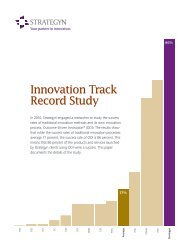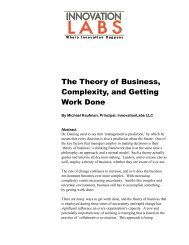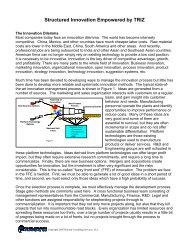the innovation master plan introduction - Innovation Management
the innovation master plan introduction - Innovation Management
the innovation master plan introduction - Innovation Management
Create successful ePaper yourself
Turn your PDF publications into a flip-book with our unique Google optimized e-Paper software.
<strong>the</strong> <strong>innovation</strong> <strong>master</strong> <strong>plan</strong>: <strong>the</strong> CEO’s guide to <strong>innovation</strong> by Langdon Morrisspecial edition for <strong>Innovation</strong><strong>Management</strong>.com<strong>introduction</strong>5Why are <strong>the</strong> o<strong>the</strong>rs not so good?This is <strong>the</strong> topic we’ll explore in this section.In our experience, <strong>the</strong>re are two enormous problems that hinder <strong>the</strong> companiesthat lag at <strong>innovation</strong>. The first is <strong>the</strong> nature of today’s change, <strong>the</strong> brutal pace thathas put so many organizations on <strong>the</strong> defensive as <strong>the</strong>y struggle to adapt toeverything that’s coming at <strong>the</strong>m.And <strong>the</strong> second is <strong>the</strong> mindset that <strong>the</strong>ir top managers bring to <strong>the</strong> problems of<strong>innovation</strong>.Let me explain.The first issue, about change, is that it’s occurring differently today than in <strong>the</strong>past. Twenty or thirty years ago most large companies were buffered from outsideimpacts by <strong>the</strong>ir size, and <strong>the</strong>y could withstand many strategic challenges just byusing <strong>the</strong>ir sheer bulk to block new entrants from accessing <strong>the</strong> market. Theyoutspent newcomers on marketing, followed <strong>the</strong>ir competitors’ successful<strong>innovation</strong>s with <strong>the</strong>ir own copies, tied up distributors with exclusivity agreements,slashed prices below cost, and used economies of scale to out-muscle <strong>the</strong>ircompetitors.But many of <strong>the</strong>se tactics don’t work as well as <strong>the</strong>y used to, and consequently<strong>the</strong> strategic vulnerabilities of all firms, large and small, is increasing.Why don’t <strong>the</strong>y work? Because <strong>the</strong> nature of marketplace competition isdifferent today than it was in <strong>the</strong> past. An example, and one of <strong>the</strong> big lessons from<strong>the</strong> meltdown of <strong>the</strong> financial sector in <strong>the</strong> fall of 2008, was <strong>the</strong> fact that <strong>the</strong> changesdevastated well established organizations and institutions just like it did to smallones. Huge banks and brokerages failed, which triggered a chain reaction thatimmediately affected automakers, airlines, consumer goods makers, and retailers.Within a month <strong>the</strong> consequences spread across <strong>the</strong> entire economy, leading to <strong>the</strong>worst recession in 75 years. This tells us that not only is competition different, but sois <strong>the</strong> marketplace itself. The scale of and interconnections between <strong>the</strong> institutionsthat compose <strong>the</strong> economy are unprecedented, and as a result its complexity is alsounprecedented.The challenges of increasing complexity and accelerating change bring us to <strong>the</strong>second issue, <strong>the</strong> problem of mindset. When <strong>the</strong> role of management is understoodto be “managing <strong>the</strong> business,” <strong>the</strong>n 99% (or more) of <strong>the</strong> effort goes to <strong>the</strong> here andnow, to sustaining market share. This is not a trivial job, and to keep a largeorganization functioning smoothly and continuing to crank out <strong>the</strong> profits thatlubricate <strong>the</strong> entire system of business growth (and of executive compensation), isenormously difficult. This is not only because of <strong>the</strong> sheer enormity and complexityof today’s organizations, but also because <strong>the</strong> markets in which <strong>the</strong>y compete todayare, as I noted, changing so fast, and <strong>the</strong>y’re so brutally competitive.However, while <strong>the</strong> sense of urgency and <strong>the</strong> feeling of time compression causedby accelerating change is certainly real, <strong>the</strong> underlying dynamics of <strong>the</strong> competitivemarketplace are not new. Seventy years ago economist Joseph Schumpeter described<strong>the</strong> overall capitalist process as “creative destruction,” and he pointed out that <strong>the</strong>natural behavior of capitalist systems brings revolution not as <strong>the</strong> result of undefinedwww.<strong>innovation</strong>management.se












